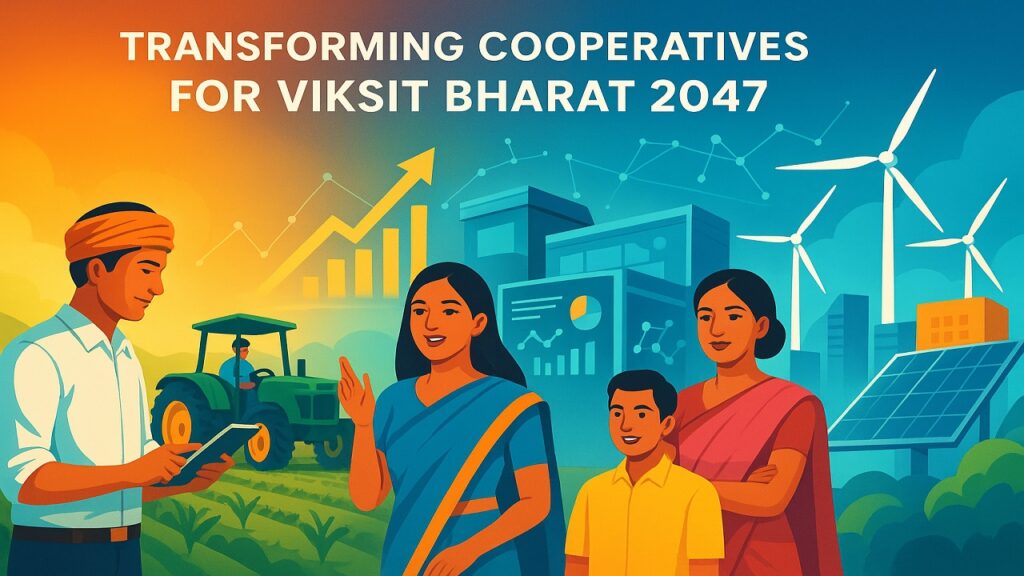Transforming Cooperatives for Viksit Bharat 2047

Context
The Government of India has recently increased funding and support schemes for the cooperative sector to strengthen its structure and promote inclusive growth. This renewed focus aims to expand the cooperative network, enhance rural livelihood opportunities, and ensure the active participation of farmers, women, and youth in cooperative enterprises.
The National Cooperative Development Corporation (NCDC) plays a key role in implementing this vision through a series of schemes that promote innovation, healthcare, digital empowerment, and women-led cooperatives.
About National Cooperative Development Corporation (NCDC)
- Established: 1963 under the NCDC Act, 1962.
- Administrative Ministry: Ministry of Cooperation, Government of India.
- Nature: A statutory organisation responsible for promoting and financing cooperative development.
Objectives of NCDC:
- To promote, strengthen, and develop cooperatives for enhanced production and productivity.
- To provide assistance for infrastructure in processing, storage, cold chain, and marketing of agricultural produce.
- To support supply chains of seeds, fertilizers, and other agricultural inputs.
- To assist income-generating cooperatives in non-farm sectors such as handloom, sericulture, poultry, fishery, dairy, and women cooperatives.
Functions of NCDC
- Provides financial assistance for the economic and social upliftment of cooperatives.
- Implements Government of India schemes and NCDC-sponsored programs.
- Focuses on promoting cooperatives among weaker sections, including SC, ST, women, and PwDs.
Major Schemes and Initiatives of NCDC
1. Yuva Sahakar – Cooperative Enterprise Support and Innovation Scheme
- Launched: FY 2019–20.
- Objective: To promote cooperative start-ups and encourage young entrepreneurs with innovative ideas.
- Support: Linked to the Cooperative Start-up and Innovation Fund created by NCDC.
- Priority: North Eastern Region, Aspirational Districts, and cooperatives of women, SC, ST, or PwD members.
Eligibility:
- Cooperative society operating for at least 3 months.
- Must have positive net worth and no cash loss in the last three years.
2. Ayushman Sahakar
- Objective: To strengthen the healthcare ecosystem through cooperatives.
- Focus Areas:
- Affordable and holistic healthcare facilities through cooperatives.
- Promotion of AYUSH-based health services.
- Support to health education, insurance, and digital health initiatives.
- Alignment: With National Health Policy and National Digital Health Mission.
Eligibility:
Any cooperative society with provisions for hospital/healthcare/health education in its bye-laws.
3. Dairy Sahakar
- Objective: To strengthen dairy cooperatives by offering financial aid for new and modernized projects.
- Scope:
- Supports the entire dairy value chain — from milk procurement and processing to branding, marketing, and export.
- Encourages renewable energy, ICT adoption, R&D, and capacity building in the dairy sector.
Eligibility:
Any cooperative registered under State or Multi-State Cooperative Acts.
4. Digital Sahakar
- Launched: FY 2021–22.
- Objective: To promote digitally empowered cooperatives in line with the Digital India initiative.
- Support: Provides financial and technical assistance to facilitate digital transformation and access to credit, grants, and subsidies.
Eligibility:
All registered cooperatives, including FPOs, FFPOs, and SHG federations, are eligible.
5. Deerghavadhi Krishak Punji Sahakar Yojana
- Objective: To provide long-term credit support to agricultural cooperatives.
- Purpose:
- Ensure steady credit flow to cooperative members.
- Boost capital formation in agriculture and allied sectors.
- Support non-farm sector activities for alternate rural employment.
Eligible Institutions:
- PACS, DCCBs, StCBs, PCARDBs, and SCARDBs.
Schemes Focused on Women Empowerment
1. Swayam Shakti Sahakar Yojana
- Launched: FY 2022–23.
- Objective: To provide financial assistance to credit cooperatives for lending to women SHGs.
- Impact: Enhances access to credit and promotes women’s economic participation in rural areas.
Eligible Institutions:
- PACS, DCCBs, StCBs, and Federated SHG Cooperatives.
2. Nandini Sahakar
- Launched: FY 2020–21.
- Objective: To empower women-led cooperatives through financial, managerial, and entrepreneurial support.
- Support Areas:
- Business planning and enterprise development.
- Capacity building and access to credit/subsidies.
Eligibility:
- Any cooperative with minimum 50% women members.
- Women cooperatives operational for at least 3 months engaged in innovative activities.
Successful Cooperative Models in India
- GUJCOMASOL (Gujarat State Cooperative Marketing Federation Ltd.) – Gujarat
- Lahoul Potato Growers Cooperative Society – Himachal Pradesh
- Jharkhand Women’s Self-Supporting Poultry Cooperative Federation – Jharkhand
- Vitthalrao Shinde Sahakari Sakhar Karkhana – Maharashtra
Schemes of Other Ministries Implemented by NCDC
- NCDC implements several Central Sector and Centrally Sponsored Schemes for holistic cooperative development.
- Focus sectors include agriculture, horticulture, fisheries, dairy, livestock, food processing, marketing, storage, and cold chain infrastructure.
- These schemes aim to modernize cooperatives and enhance their socio-economic contribution.
Recent Developments in the Cooperative Sector
1. Grant-in-Aid to NCDC
- Approved by Union Cabinet: Total outlay of ₹2,000 crore (2025–26 to 2028–29).
- Annual Release: ₹500 crore per year.
- Impact: Enables NCDC to leverage up to ₹20,000 crore from the market to fund new ventures, expansion projects, and working capital needs of cooperatives.
2. National Cooperative Policy 2025
- Vision: To revitalize India’s cooperative movement in line with Viksit Bharat @2047.
- Guiding Principle: “Sahkar se Samriddhi” – Prosperity through Cooperation.
- Focus Areas:
- Building a transparent, technology-driven, and professionally managed cooperative ecosystem.
- Promoting inclusive growth through collective participation.
- Strengthening the legal and institutional framework for cooperatives.
Implementing Partners:
Seven major cooperative institutions — IFFCO, NAFED, AMUL, KRIBHCO, NDDB, NCEL, and NABARD — are collaborating to promote sustainable cooperative growth.
Conclusion
The Government’s enhanced support through NCDC reflects a renewed vision for cooperative-led growth.
By integrating digital empowerment, women participation, and youth entrepreneurship, the cooperative model is evolving as a pillar of inclusive development.
These efforts align with the larger goal of Atmanirbhar Bharat and Viksit Bharat 2047, ensuring that the spirit of cooperation becomes a key driver of India’s socio-economic transformation.
Source : PIB
